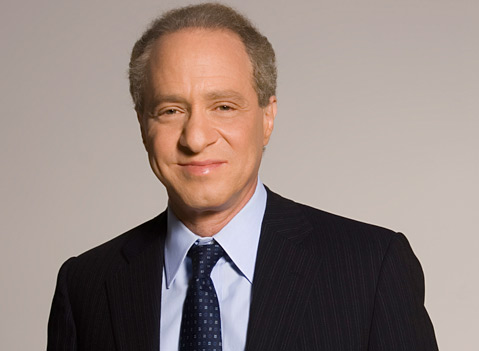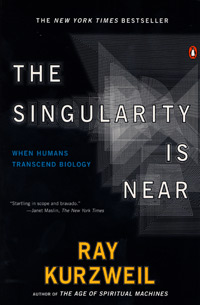Men Must Merge with Machines
An Interview with Inventor and Futurist Raymond Kurzweil

Some have called inventor, author, and future-thinker Raymond Kurzweil the Thomas Edison of the 21st century, and rightly so. The National Inventor Hall of Fame inductee began his career making technology that helped blind people read — Stevie Wonder, in fact, is a good friend because of this — and then went on to pen books about computer science, nutrition, spirituality, and the merging of men with machines.
He comes to share his thoughts with Santa Barbara on March 6, so we asked our occasional correspondent Lynda Weinman, of Lynda.com, to send Kurzweil a few thoughtful questions. Here’s the result of their email conversation.
What will your speaking topic focus be for the UCSB Arts & Lectures series?
I will talk about why this is a period of the empowerment of the individual. The tools to change the world are in everyone’s hands. Facebook, Google, and many other world changing ventures were started with nothing more than thousand dollar laptops. A kid in Africa with a smart phone today has access to more knowledge and information than the President of the United States did 15 years ago.
The phenomenon that is powering this change is the exponential growth of information technology. Computer technology today is billions of times more powerful per constant dollar than it was when I was a student and is continuing to double in price-performance in less than a year. Health and medicine has recently become an information technology and will, therefore, also now be subject to what I call the “law of accelerating returns.” I will discuss the implications of these changes.
It seems like for you it is not man versus machine, but man plus machine. Can you elaborate on this vision of convergence?
It is already human plus machine. There is no question but that we are smarter today than we were, say, a decade ago because of the pervasive brain extenders we all share. The fact that these devices are not (yet) inside our bodies and brains is a distinction without a difference.
However, another exponential progression is the shrinking of technology. My cell phone is 100,000 times smaller than the computer thousands of us shared when I was a student at MIT. It is millions of times less expensive and thousands of times more powerful. We are shrinking technology at a rate of 100 in 3D volume per decade so these technologies will be 100,000 times smaller again in 25 years. At that time, powerful computers and little robots will be the size of blood cells and we will introduce them into our bodies noninvasively in the bloodstream to keep us healthier and to continue making us smarter.
Over and over again in your writing and work you discuss three important factors — price performance, capacity, and bandwidth — for determining trends. How did you come upon these three ideas as the “influencers” or “predictors”?
Starting 30 years ago I was looking for some way to predict anything about the future because I realized that timing was critical to be successful as an inventor. I realized that the world would be a different place by the time I finished an invention. It had to make sense for that world, not the world when I started. I made a surprising discovery, that the fundamental measures of information technology, such as price-performance, capacity, and bandwidth follow predictable and exponential trajectories.
What do you predict in the next five to 10 years for technology convergence — the lines dissolved between the human and technology?
If we go out 10 years, the merger of biology and computer science will be complete and the ability to reprogram our own genetic code (by turning genes off with RNA interference, adding new genes with gene therapy, growing new cells, tissues, and organs with stem cells) will be mature. We will see dramatic gains against disease. This will be fully mature 15 years from now.

Virtual and augmented reality will be mainstream and ubiquitous. Already, Google is preparing to introduce goggles that provide augmented reality so that you see the real world but little pop ups help guide you through it. Search engines won’t wait to be asked, they’ll watch and listen to what you’re doing and saying and give you useful information. There will be commonplace self driving cars within 10 years. Already, Nevada is allowing them on a test basis.
You have coined the term “The Spiritual Machine.” What do you mean be that term?
A spiritual machine is a conscious machine. Consciousness is the true spiritual value. If an entity — such as a person — is conscious, we consider that entity to be spiritually valuable. If we have an entity that is not conscious, such as a simple machine, it has little spiritual value other than what it might be able to do for a conscious person. I’m saying that computers will be indistinguishable from humans in the 2030s so they will constitute spiritual machines. Humans are basically spiritual machines today.
Another term you have coined is “singularity.” Help our readers/listeners understand what this concept means in your work.
We are going to merge with the intelligent machines we are creating to make ourselves smarter. As I mentioned, we can consider the brain extenders we have today to already be part of us, even if most of them are not yet inside our bodies and brains. These machines will grow in capability exponentially while they shrink in size exponentially so as we get to the 2040s, they will be many times more capable than unenhanced human intelligence. That is such a singular change in human history that we borrow a metaphor from physics and call it a singularity.
Since I have a passion for teaching and learning, I am interested in the work you are doing in education (Kurzweil Educational Systems, Inc.) that help people with learning difficulties and those who are blind or visually impaired. What are some of your current breakthroughs or things that excite you in this area?
We have a free e-reader called Blio (available at Blio.com) that is fully accessible to the blind. It can read books and display them with synchronized highlighting, which helps people with learning disabilities develop their reading skills.
Since you mention education, I will mention Singularity University, which I founded with Peter Diamandis, chair of the X-Prize foundation. It is sponsored by Google and other companies and has a campus provided by NASA. The subject matter are exponentially growing information technologies but the unique aspect of the program is the entrepreneurial idea of learning by doing. The students self-organize into teams of 8 to 10 students and take on a major world challenge. The goal of each project is to positively affect a billion people within 10 years.
4•1•1
Renowned inventor and future thinker Raymond Kurzweil will discuss all this and much more on at UCSB’s Campbell Hall on Tuesday, March 6, 8 p.m. Call 805-893-3535 or go here for more tickets and information.



